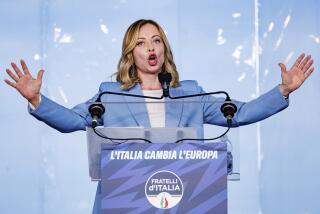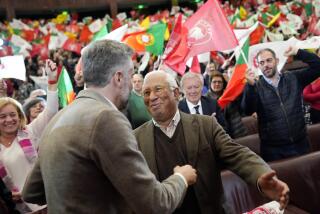Italy’s Left Applauds New Premier
- Share via
ROME — Vezio’s Bar in central Rome is a hole-in-the-wall monument to the Cold War. Every surface except the floor is covered with red banners, hammer-and-sickle insignia, revolutionary slogans and portraits of Marx, Lenin, Che Guevara and other fallen idols of the left.
One of this shrine’s few living heroes, the man with the thin mustache in the photograph on the door, is Massimo d’Alema, who was sworn in Wednesday as Italy’s prime minister to the exuberant toasts of Vezio’s clientele.
D’Alema, 49, is the first ex-Communist to lead the government of a major West European nation. He is widely known as a skillful politician who helped steer his party from communism into the mainstream European left after the collapse of the Berlin Wall.
But to many here who remain red at heart, D’Alema is still one of them, and that is one reason his surprise selection is stirring Cold War passions that Italians have long been trying to bury.
“He never renounced his ideological roots or his ideals of social justice,” said Vezio Bagazzini, 58, a lifelong Communist who owns the bar. “He merely adapted them to a world that has changed.”
President Oscar Luigi Scalfaro, a centrist, tapped D’Alema on Friday to form a government after Prime Minister Romano Prodi, leader of the center-left Olive Tree coalition, lost a parliamentary vote of confidence and resigned.
D’Alema returned Wednesday with a coalition of parties from the far left to the center-right that together command a majority in Parliament. His government will include two unreformed Communists--the first to hold Cabinet posts since 1947.
Reacting furiously to the fall of a taboo, foes of D’Alema were quick to harp on the Communist identity that he inherited from his father, nourished at summer youth camp in the Soviet Union, carried on a steady rise through the Italian Communist Party and wore proudly into his 40s.
The Vatican newspaper L’Osservatore Romano commented: “Fifty years after the hard-won victory of liberty and democracy over communism [in Italy], the head of state has entrusted the task of forming a new government to an apparatchik of the former Communist Party.”
“He is practicing the methods Communists have always used to win power--taking advantage of fellow travelers whom history then defines as useful idiots,” said Silvio Berlusconi, the leader of Italy’s center-right opposition, which had pressed Scalfaro to call new elections.
Notably absent from the outcry is the voice of the United States, which worked for decades to bar Communists from power here.
U.S. officials say they accept D’Alema as a democrat and believe that he will maintain Italy’s active role in NATO.
“There’s this residual expectation [among Italians] on the right that the U.S. is going to stand up and say, ‘We can’t accept this,’ ” a Western diplomat said in Rome. “But it would be absurd to draw some ideological dividing line.”
“We’ve got absolutely no problem,” said Jeff Murray, a U.S. State Department spokesman. “We look forward to working with [D’Alema] and his government.”
To critics at home, D’Alema insists that the Cold War is over. “The men and ideas that openly fought for many years can also collaborate,” he said last week.
Many Italians hope that he can make that happen.
“He knows how to reconcile the irreconcilable, to put together the devil and holy water,” said Luciano Sardelli, a political rival.
But holding his eight-party alliance of Communists, socialists, Greens, Christian Democrats and assorted centrists together will not be easy--even without the ideological rivalry that divided postwar Italy more deeply than any other country in Western Europe.
Backed by the Vatican and Washington, Italy’s centrist Christian Democrats controlled the government for more than four decades after the 1948 elections, shutting out a 1.7-million-member Communist Party that drew as much as a third of the vote. Priests instructed Roman Catholics to vote against Communists on pain of excommunication from Italy’s dominant church.
A senior partner in D’Alema’s coalition, former President Francesco Cossiga, once led a secret, CIA-backed paramilitary army that stood ready to repel a Soviet invasion or, Italian leftists believe, to topple any leftist government that might be elected.
D’Alema, a native Roman, grew up in this charged atmosphere but tempered his beliefs to try to lead Italy out of it.
Giuseppe d’Alema, a member of Parliament, took his son to a Communist Party congress at age 13. After philosophy studies at the University of Pisa, the younger D’Alema learned from Soviet instructors at the party’s school for cadres. He became Communist Youth leader at 26, a member of the party secretariat at 37 and a member of Parliament at 38.
Down to earth, dry of wit and often abrasive, he earned the nickname Baffino (Little Mustache), as opposed to Baffone (Big Mustache), which is how Italian Communists once referred to the bristly Soviet dictator Josef Stalin.
But Italian communism was never close to the Soviet model. During a visit to Moscow in 1984, D’Alema recalled, Italian Communist leader Enrico Berlinguer told him that there were three things to know about Soviet communism: “The leaders always tell lies, their agriculture doesn’t work, and the wrapping on the sweets they offer always sticks.”
By 1989, Italian Communists were losing voters at home and watching comrades lose power in Eastern Europe. Drawing inspiration from such European social democrats as Germany’s Willy Brandt and Sweden’s Olof Palme, D’Alema helped transform the party’s ideology that year, later changing its name to Democratic Party of the Left and ridding its flag of the hammer and sickle.
In 1993, he became leader of the party, which had been abandoned by then by a faction of unreformed Communists but was still the largest party in Italy. Three years later, he built the Olive Tree coalition and managed its victory in parliamentary elections. However, fearing that as an atheist ex-Communist he could not win the votes, he allowed Prodi, a centrist Catholic, to lead the ticket.
Until last week, D’Alema publicly dismissed his chances of becoming prime minister, saying that Italy’s ex-Communists were “children of a lesser god.”
He once said he moved away from Marxism “because its predictions” of world revolution, dictatorship of the proletariat and a classless society “did not come true.”
With D’Alema’s support for tax hikes and spending cuts, Prodi achieved Italy’s entry into the 11-nation European Monetary Union that will adopt the euro as a single currency in January. D’Alema’s first task will be to ensure that step by doing what Prodi couldn’t--pushing through a tight 1999 budget.
Then D’Alema is expected to join France’s socialist government in insisting that politicians, not bankers, run the currency club so that governments can spend more freely to create jobs for Europe’s 21 million unemployed.
D’Alema’s coalition could break up not over ideology but over conflicting visions of Italy’s electoral system, political analysts say.
Seeking to end chronic instability that has produced 56 governments here since World War II, D’Alema proposes reforming the constitution to create a U.S.-style two-party system, pitting his own party against a grouping on the right.
However, Cossiga, his coalition partner, wants to rebuild the Christian Democratic center, which collapsed amid Italy’s corruption scandals of the early 1990s.
A stalemate would be frustrating for D’Alema, who once lamented that “Italians are respected the world over, but Italy is not. We have not had the capacity to build a country worthy of Italians’ ingenuity and creativity.”
Times staff writer Tyler Marshall in Washington contributed to this report.
More to Read
Sign up for Essential California
The most important California stories and recommendations in your inbox every morning.
You may occasionally receive promotional content from the Los Angeles Times.













